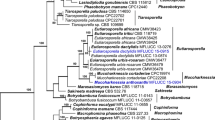Abstract
The Clypeosphaeriaceae is retained to include sixteen genera.Apioclypea, Ceratostomella, Clypeophysalospora, Clypeosphaeria, Crassoascus, Jobellisia, Oxydothis andUrosporella are described and illustrated, whileApiorhynchostoma, Brunneiapiospora, Capsulospora, Duradens, Frondispora, Leiosphaerella, Pseudovalsaria andStereosphaeria are discussed. Genera in the Clypeosphaeriaceae are distinguished from those in, the Amphisphaeriaceae (sensu stricto). Their ascomata are immersed and typically clypeate. Asci are 8-spored, unitunicate, cylindrical, with a J+ or J−, apical ring. Ascospores are usually ellipsoidal or cylindrical, brown or hyaline, unicellular, pseudoseptase or septate, at times with appendages or germ pores. The Clypeosphaeriaceae is considered a member of the Amphisphaeriales and the differences between the Clypeosphaeriaceae and Amphisphaeriaceae are discussed. We are unsure if the Clypeosphaeriaceae as we define it is monophyletic.
Similar content being viewed by others
Literature cited
Andersson, K., Eriksson, O. E. and Landvik, S. 1995. Boliniaceae transferred to Sordariales (Ascomycota). Syst. Ascomycet.14: 1–16.
Arx, J. A. von and Müller, E. 1954. Die Gattungen der amerosporen Pyrenomyceten. Beitr. Kryptogamenfl. Schweiz11 (1): 1–434.
Atkinson, G. F. 1897. Some fungi from Alabama. Bull. Cornell Univ. (Sci.)3: 1–50.
Barr, M. E. 1966. Observations onUrosporella. Mycologia58: 690–693.
Barr, M. E. 1989.Clypeosphaeria and the Clypeosphaeriaceae. Syst. Ascomycet.8: 1–8.
Barr, M. E. 1990. Prodromus to nonlichenized, pyrenomycetous members of class Hymenoascomycetes. Mycotaxon39: 43–184.
Barr, M. E. 1993. Redisposition of some taxa described by J. B. Ellis. Mycotaxon46: 45–76.
Barr, M. E. 1994. Notes on the Amphisphaeriaceae and related families. Mycotaxon51: 191–224.
Barrasa, J. M., Checa, J. and Martínez, A. T. 1993.Crassoascus, a new nonstromatic genus in the Clypeosphaeriaceae. Mycotaxon46: 299–305.
Clements, F. E. and Shear, C. L. 1931. The genera of fungi. H. W. Wilson, New York.
Dennis, R. W. G. 1978. British Ascomycetes. J. Cramer, Vaduz.
Eriksson, O. E. and Hawksworth, D. L. 1987. Outline of the ascomycetes. Syst. Ascomycet.6: 259–337.
Eriksson, O. E. and Hawksworth, D. L. 1993. Outline of the ascomycetes. Syst. Ascomycet.12: 51–257.
Fröhlich, J. and Hyde, K. D. 1994. NewOxydothis species associated with palm leaf spots in north Queensland, Australia. Mycol. Res.98: 213–218.
Fuckel, L. 1870. Symbolae mycologicae. Jahrb. Nass. Ver. Naturk.23–24: 1–459.
Hawksworth, D. L., Sutton, B. C. and Ainsworth, G. C. 1983. Ainsworth & Bisby's Dictionary of the fungi, 7th ed. Commonw. Mycol. Inst. Kew.
Hawksworth, D. L., Kirk, P. M., Sutton, B. C. and Pegler, D. N. 1995. Ainsworth & Bisby's Dictionary of the fungi, 8th ed. CAB International, Wallingford.
Höhnel, F. von. 1919. Fragmente zur Mykologie XXIII. Sitzungsber. Akad. Wiss. Wien, Math.-Naturwiss. Kl., Abt. 1,128: 535–625.
Hyde, K. D. 1993a. Fungi from palms. VI. Reflections onOxydothis and related genera. Sydowia45: 204–225.
Hyde, K. D. 1993b. Fungi from palms. VII. The genusOxydothis from rachides of palms in north Queensland, including five new species. Sydowia45: 226–240.
Hyde, K. D. 1994a. Fungi from rachides ofLivistona in the Western Province of Papua New Guinea. Bot. J. Linn. Soc.116: 315–324.
Hyde, K. D. 1994b. Fungi from palms. XIII. The genusOxydothis, a revision. Sydowia46: 265–314.
Hyde, K. D. 1996. Fungi from palms. XXVII.Capsulospora gen. nov., with three new species. Sydowia48: 111–121.
Hyde, K. D., Fröhlich, J. and Taylor, J. E. 1996. Diversity of Ascomycetes on palms in the Tropics. In: Biodiversity of tropical microfungi. (ed. by Hyde, K. D.), pp. 141–156. Hong Kong Univ. Press, Hong Kong.
Hyde, K. D., Fröhlich, J. and Taylor, J. E. 1998. Fungi from palms. XXXV. Reflections on unitunicate ascomycetes with apiospores. Sydowia50: 21–80.
Kang, J. C., Kong, R. Y. C. and Hyde, K. D. 1998a. Studies on the Amphisphaeriales. 1. Amphisphaeriaceae (sensu stricto) and its phylogenetic relationships inferred from 5.8S rDNA and ITS2 sequences. Fungal Diversity1: 147–157.
Kang, J. C., Hyde, K. D. and Kong, R. Y. C. 1998b. Studies on the Amphisphaeriales 2. The Amphisphaeriaceae (sensu stricto). Mycol. Res.103: 53–64.
Kirschstein, W. 1939. Ueber neue, seltene und kritische Ascomyceten und Fungi imperfecti. II. Ann. Mycol.37: 88–140.
Lambotte, E. 1887. La flore mycologique de la Belgique, Suppl. 1. Mém. Soc. R. Sci. Lièg, sér. 2,14: 1–350.
Miller, J. H. 1949. A revision of the classification of the Ascomycetes with special emphasis on the Pyrenomycetes. Mycologia41: 99–127.
Munk, A. 1957. Danish Pyrenomycetes. Dansk Bot. Arkiv.17: 1–491.
Penzig, O. and Saccardo, P. A. 1897. Diagnoses fungorum novorum in insula Java collectorum. Series secunda. Malpighia11: 491–530.
Petrak, F. 1923. Mykologische Notizen. VI. Numbers 201–300. Ann. Mycol.21: 182–335.
Rappaz, F. 1987 Taxonomie et nomenclature, des Diatrypacees à asques octospores. Mycol. Helvetica2: 285–648.
Saccardo, P. A. 1978. Fungi veneti novi vel eritici vel mycologiae venetae addendi, 9. Michelia,1:361–445.
Samuels, G. J. and Rossman, A. Y. 1987. Studies in the Amphisphaeriaceae (sensu lato) 2.Leiosphaerella cocoes and two new species ofOxydothis on palms. Mycotaxon28: 461–471.
Samuels, G. J. and Rogerson, C. T. 1990. New Ascomycetes from theGuayana Highland. Mem. N.Y. Bot. Gard.64: 165–183.
Schröter, J. 1897. Die Pilze Schlesiens. In: Kryptogamen-Flora on Shlesien, (ed. by Cohn, F.),3 (2): 1–285.
Spooner, B. M. 1986. New or rare British microfungi from, Esher Common, Surrey. Trans. Br. Mycol. Soc.86: 401–408.
Swart, H. J. 1981. Australian leaf-inhabiting fungi Xi.Phyllachora eucalypti. Trans. Br. Mycol. Soc.76: 89–95.
Winter, G. 1887. Die Pilze Deutschlands, Oesterreichs under Schweiz. 2. Abt., Ascomyceten: Gymnoasceen und Pyrenomyceten. In: Kryptogamen-Flora von Deutschland, Oesterreich und der Schweiz, (ed. Rabenhorst, L.), 2. Aufl.,1 (2): 1–928.
Author information
Authors and Affiliations
About this article
Cite this article
Kang, J.C., Hyde, K.D. & Kong, R.Y.C. Studies on the amphisphaeriales I. The clypeosphaeriaceae. Mycoscience 40, 151–164 (1999). https://doi.org/10.1007/BF02464294
Accepted:
Issue Date:
DOI: https://doi.org/10.1007/BF02464294




